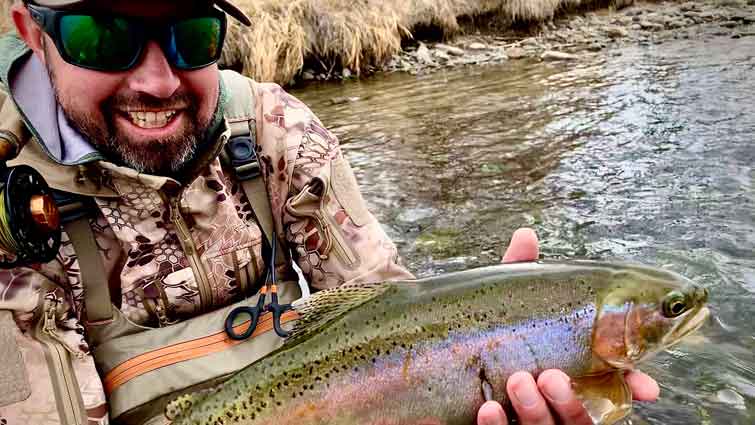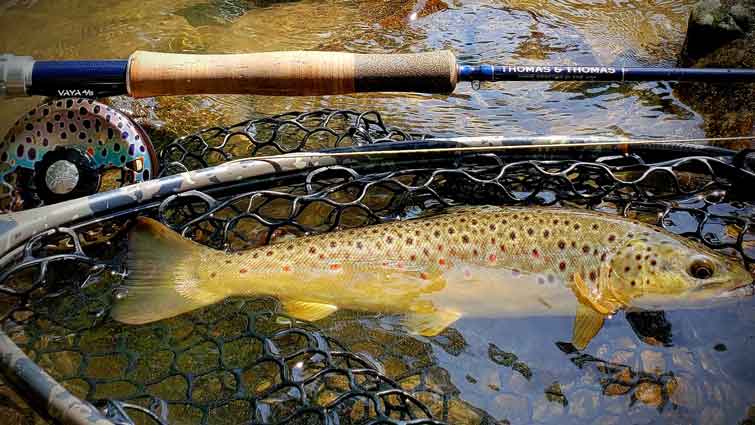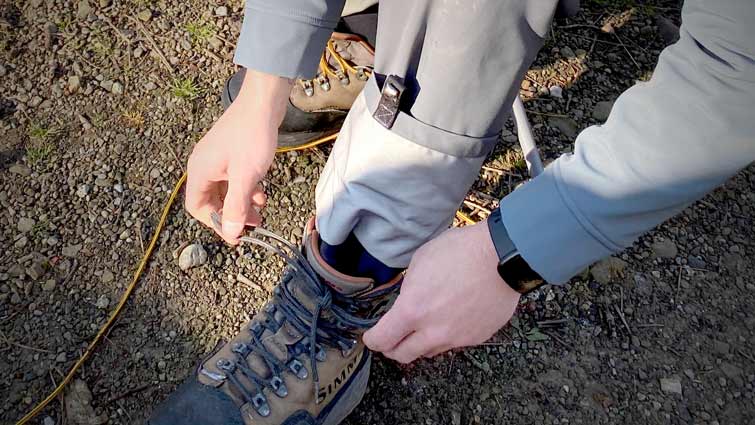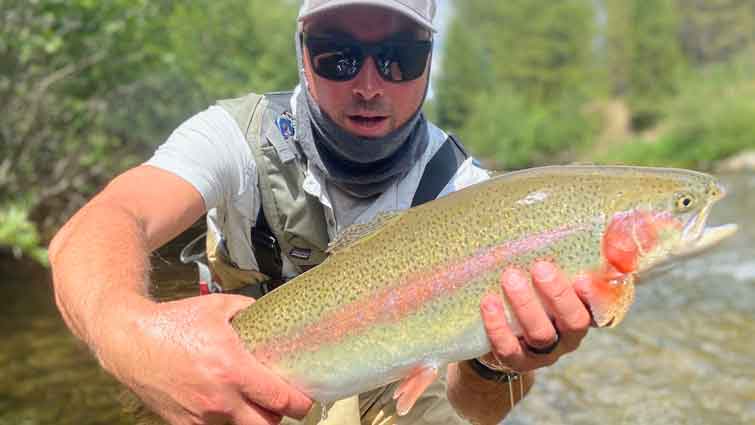There are many different opinions on the best fly rod size and weight for fly fishing for trout and other species. Some anglers prefer a light and short fly rod in their fly fishing gear, while others prefer a heavier and longer fly rod. So, what is the right size and weight for you?
As a general rule, the ideal or most common size and weight fly rod for trout fishing is a 9-foot 5-weight rod. This has been commonly referred to as the standard for trout fishing.

The answer to that question depends on your experience level, fishing conditions, and the trout species you are targeting. A general rule of thumb is that the heavier the fly rod, the larger the fish you can catch. In this article, we’ll look at what size rods work best for small and large trout fishing, as well as what conditions can affect the weight of the rod you should choose.
What Size Rod Is Best for Trout Fishing?
Trout fishing can be done with a variety of fly rod sizes. If you are a beginner or inexperienced angler, it might be a good idea to start with a lighter-weight fly rod. This will give you enough power to cast in varying conditions and enough delicacy to feel the fish bite.
The best-sized rod for trout fishing is a 9-foot 5-weight rod. This has been commonly referred to as the standard for trout fishing.

When it comes to trout fishing, you want to use a relatively light fly rod with a medium to fast action. This will help you cast accurately and delicately, which is key when fishing for trout. Heavier-weight rods are often used for larger fish, like bass or salmon. If you are targeting smaller trout, using a lighter-weight rod will increase your chances of landing them.

Fly Fishing Rods: Size Guide
Fly fishing rods come in various sizes, and the size you choose will depend on the weight of the line you are using and the type of fish you're fishing for. In general, the larger the fish, the heavier the rod you'll need.
Here's a quick guide to help you choose the right size fly fishing rod:
|
Rod Size (Weight) |
Type of Fish |
|
3-4 |
Small trout |
|
5 |
Average trout/ Typical fly fishing |
|
6-7 |
Bass/ Streamer fishing |
|
8-9 |
Bass, Pike, Large Trout |
|
10-12 |
Tarpon/ Large saltwater fish |

Depending on the size of fish you're going after, you will need a fly rod that can cast a certain weight of line. For smaller trout, you'll want to use a 2-4 weight fly rod. For bigger trout, go for a 4-6 weight rod.
Heavier fly rods are not only good for casting larger flies, but they also provide more leverage when fighting fish. This can be helpful when trying to land larger trout.
On the other hand, lighter-weight rods are easier to use and can be more forgiving when casting in windy conditions. They are also better suited for smaller streams and rivers.

Here are some of the most common fish and the size rod you should be using for them:
- Panfish: fly rod weight 0-4
- Average Trout: fly rod weight 4-6
- Smaller Trout: fly rod weight 0-4
- Smallmouth Bass: suggested fly rod weight 5-8
- Largemouth Bass: suggested fly rod weight 5-9
- Carp: suggested fly rod weight 6-10
- Steelhead: suggested fly rod weight 7-9
- Salmon: suggested fly rod weight 8-10
- Bonefish, Redfish: suggested fly rod weight 7-9
- Striped Bass: fly rod weight 8-12
- Tarpon: fly rod weight 10-12
When choosing a fly rod for trout, you want to find one that matches the size of fish you'll be targeting. For smaller streams and rivers, you'll need a lighter fly rod (under four weight). For larger streams and rivers, you can use a heavier fly rod (5-12 weight).
Keep in mind that when using a heavier fly rod, you may have more difficulty casting in tight spaces. If that's the case, then you might want to consider using a lighter fly rod, even if the fish are bigger.

Fly Fishing Reels for Trout Rods
When selecting a trout fly reel for your rod, you should consider the kind of water you will be fishing in. If you're fishing in fast-moving water or a stream, you'll need a reel with more drag to keep the line from coming off your reel.
If you're going to fish in calm seas, it's wise to choose a reel with less drag. The majority of fly reels are measured in pounds and range from 3 to 12 ounces. As a rule of thumb, your fly reels should complement each other in terms of weight.
Choosing the right fly line for your trout fishing rod is also important. Heavier lines are better suited for rods with a lot of power and can cast larger flies. Lighter lines are good for delicate presentations with smaller flies. You don't want to use a fly line that's too heavy or too light for your fly rod. This will make casting difficult and could result in snapped lines.
When choosing the weight of your fly line, take into account the weight of your fly reel and how much backing you'll need.

What Weight Fly Rod for Small Trout?
Small trout are often found in ponds and streams where the current is slow to moderate. A 4- or 5-weight fly rod is perfect for these conditions. It's light enough to make delicate casts but has enough power to handle larger trout.
In general, a 4-weight fly rod is a good all-around choice for small trout fishing. It's light enough to make delicate casts in small streams but has enough power to handle larger trout in larger streams and rivers.
Larger trout are usually found in larger streams and rivers where the current is stronger. For fishing in these conditions, you'll need a fly rod with more weight. A 6-, 7- or 8-weight fly rod will give you the power you need to cast larger flies and fight bigger trout.
When choosing a fly rod for trout fishing, it's important to consider the weight of the fish you'll be targeting. Heavier rods are better suited for larger trout, while lighter rods are perfect for smaller fish.

What Is a 4-Weight Fly Rod Good for?
4-weight fly rods are perfect for trout fishing in smaller streams and rivers. They have enough power to handle smaller fish but are light enough to be easily handled. A 4-weight fly rod is also a good choice for fishing in windy conditions, as it will give you more accuracy when casting.
A good 4-weight rod must be more than simply a dry fly rod, and the finest 4-weights are ideal for nymphing at closer ranges and pitching smaller streamers when conditions demand it.

How Do I Know What Weight Fly Rod I Need?
When looking for a fly rod, the first thing you need to determine is what weight fly rod you need. This will depend on the size of fish you are targeting and the conditions you will be fishing in.
To know the right weight fly rod to choose, take into account the fish you're fishing for, the water conditions, and your experience level. While there are specific weights that are ideal for trout fishing, these factors can help you choose what is right for your situation.
- Fish species: Different fish species require different fly rod weights in order to be effective. Larger fish will require a heavier fly rod, while smaller fish can be caught with a lighter fly rod.
- Water conditions: The weight of the fly rod you choose will also depend on the water conditions you will be fishing in. If you will be fishing in fast-moving water, then you will need a heavier fly rod to combat the current. Conversely, if you will be fishing in calm water or slow-moving streams, then a lightweight fly rod is more appropriate.
- Your experience level: If you are just starting out fly fishing, it is best to stick with a lightweight fly rod until you get a feel for casting and fishing with a fly rod. Experienced anglers who are comfortable with fly casting can use a heavier fly rod to battle the current and catch bigger fish.
Not all trout species require the same weight fly rod. For example, rainbow trout can be caught with a lightweight fly rod, while brown trout and brook trout will require a heavier fly rod.

What Weight Is Best for Trout?
Trout fishing is a popular sport, and anglers are always looking for the best way to catch trout. Fly fishing is one of the most common methods used to fish for trout, and the weight of your fly rod is an important factor when trying to determine the best way to fly fish for trout.
The best weight for trout fishing is a 4 or 5-weight rod. This weight will allow you to cast a fly in a variety of wind conditions, and it will also provide enough weight to fight larger trout. A 6 or 7-weight rod is too heavy for most trout fishing situations, and it will be difficult to control the fly in a current.
8 and 9-weight rods are designed for saltwater fishing, and they are too heavy for trout fishing. 10 and 11-weight rods are also too heavy, and they are best suited for large fish such as salmon or steelhead.
There are a variety of factors that you need to consider when choosing the right weight fly rod for trout fishing. The type of water you will be fishing in is a major consideration – if you will be fishing in moving streams, then a lightweight fly rod is more appropriate. If you are fishing in still water, such as lakes or ponds, then you can use a heavier fly rod. Another thing to consider is your experience level – if you are just starting out, then you will want to choose a fly rod that is easy to use and is not too heavy.
Trout fishing is a popular sport, and there are a variety of different fly rods available on the market. When choosing the right fly rod for trout fishing, you need to consider the type of water you will be fishing in, your experience level, and the weight of the fly rod. Heavier fly rods are better for still water, while lighter fly rods are more appropriate for moving streams. If you are just starting out, then choose a fly rod that is easy to use and does not require too much power to cast.





2 comments
Matthew
Hi Don,
Typically you will want to match the line weight to the weight of the fly rod. 5 wt line for 5wt rod. But there are occasions where you might want to go up a weight in line to help load your rod. I have a stiff 7 weight that I like to use for streamer fishing and carp fishing, and I have an 8wt line on it. The extra weight helps load the rod faster, so I can shoot out more line with fewer back casts.
I hope this helps.
Matthew Bernhardt
Founder Drifthook Fly Fishing
Hi Don,
Typically you will want to match the line weight to the weight of the fly rod. 5 wt line for 5wt rod. But there are occasions where you might want to go up a weight in line to help load your rod. I have a stiff 7 weight that I like to use for streamer fishing and carp fishing, and I have an 8wt line on it. The extra weight helps load the rod faster, so I can shoot out more line with fewer back casts.
I hope this helps.
Matthew Bernhardt
Founder Drifthook Fly Fishing
Don Carothers
How flexible are flyrods to use different weight lines? Ie, is a 5wt rod only used with 5 wt line?
How flexible are flyrods to use different weight lines? Ie, is a 5wt rod only used with 5 wt line?